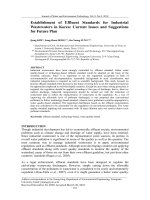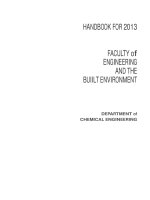63 Empowering Learners through the Standards for Mathematical Practice of the Common Core
Bạn đang xem bản rút gọn của tài liệu. Xem và tải ngay bản đầy đủ của tài liệu tại đây (2.31 MB, 95 trang )
Learners through
the Standards for
Mathematical
Practice of the
Common Core
Juli K. Dixon, Ph.D.
University of Central
Florida
Solve this…
3 ÷ 1/7
Perspective…
When asked to justify the solution to 3 ÷ 1/7
A student said this…
Perspective…
When asked to justify the solution to 3 ÷ 1/7
A student said this…
“Just change the division sign to
multiplication and flip the fraction after
the sign. 3 ÷ 1/7 becomes 3 x 7/1. So I
find 3/1 x 7/1 which is 21/1 or 21.”
Perspective…
When asked to justify the solution to 3 ÷ 1/7
A student said this…
“Just change the division sign to
multiplication and flip the fraction after
the sign. 3 ÷ 1/7 becomes 3 x 7/1. So I
find 3/1 x 7/1 which is 21/1 or 21.”
Is this an acceptable
justification?
Perspective…
When asked to justify the solution to 3 ÷ 1/7
Another student said
this…
“I know there are 7 groups of 1/7 in
one whole. Since there are three
wholes, I have 3 x 7 or 21 groups of
1/7 in 3 wholes so 3 ÷ 1/7 = 21.”
Perspective…
When asked to justify the solution to 3 ÷ 1/7
Another student said
this…
“I know there are 7 groups of 1/7 in
one whole. Since there are three
wholes, I have 3 x 7 or 21 groups of
1/7 in 3 wholes so 3 ÷ 1/7 = 21.”
How is this justification different and
what does it have to do with the
Background of the
CCSSM
• Published by the National Governor’s
Association and the Council of Chief
State School Officers in June 2010
• Result of collaboration from 48 states
• Provides a focused curriculum with an
emphasis on teaching for depth
Background of the
CCSSM
45
States + DC have adopted the Common Core State Stan
Minnesota adopted the CCSS in ELA/literacy o
Background of the
CCSSM
“… standards must address the problem
of a curriculum that is ‘a mile wide and
an inch deep.’ These Standards are a
substantial answer to that challenge”
(CCSS, 2010, p. 3).
Background of the
CCSSM
“… standards must address the problem
of a curriculum that is ‘a mile wide and
an inch deep.’ These Standards are a
substantial answer to that challenge”
(CCSS, 2010, p. 3).
We’ve already met this challenge in
Florida. How can we use our momentum
to take us further and deeper?
NGSSS Content
Standards Wordle
CCSSM Content
Standards Wordle
Content Standards
• Standards – define what students should
know
and be able to do
• Clusters – group related standards
• Domains – group related clusters
• Critical Areas – much like our big ideas
Content Standards
Measurement and Data
K.MD
Describe and compare measurable attributes.
1.Describe measurable attributes of objects, such as length or
weight. Describe several measurable attributes of a single object.
2.Directly compare two objects with a measurable attribute in
common, to see which object has “more of”/“less of” the attribute,
and describe the difference. For example, directly compare the
heights of two children and describe one child as taller/shorter.
Classify objects and count the number of objects in each
category.
3.Classify objects into given categories; count the numbers of
objects in each category and sort the categories by count.
Content Standards
Domain
Cluster
Measurement and Data
K.MD
Standard
Describe and compare measurable attributes.
Standard
1.Describe measurable attributes of objects, such as length or
weight. Describe several measurable attributes of a single object.
Cluster
2.Directly compare two objects with a measurable attribute in
common, to see which object has “more of”/“less of” the attribute,
and describe the difference. For example, directly compare the
heights of two children and describe one child as taller/shorter.
Standard
Classify objects and count the number of objects in each
category.
3.Classify objects into given categories; count the numbers of
objects in each category and sort the categories by count.
Background of the
CCSSM
The CCSSM consist of Content
Standards and Standards for
Mathematical Practice.
“The Standards for Mathematical
Practice describe varieties of expertise
that mathematics educators at all levels
should seek to develop in their
students” (CCSS, 2010, p. 6).
Making Sense of the
Mathematical
Practices
The
Standards for Mathematical
Practice are based on:
• The National Council of Teachers of
Mathematics’ (NCTM) Principles
and Standards for School
Mathematics (NCTM, 2000), and
• The National Research Council’s
(NRC) Adding It Up (NRC, 2001).
Making Sense of the
Mathematical
Practices
NCTM
Process Standards:
• Problem Solving
• Reasoning and Proof
• Communication
• Representation
• Connections
Making Sense of the
Mathematical
Practices
NRC
Strands of Mathematical Proficiency:
• Adaptive Reasoning
• Strategic Competence
• Conceptual Understanding
• Procedural Fluency
• Productive Disposition
Making Sense of the
Mathematical
Practices
NRC
Strands of Mathematical Proficiency:
• Adaptive Reasoning
• Strategic Competence
• Conceptual Understanding
• Procedural Fluency
• Productive Disposition
Standards for
Mathematical Practice
Wordle
Perspective…
According to a recommendation
from the Center for the Study of
Mathematics Curriculum (CSMC,
2010), we should lead with the
Mathematical Practices. Florida
is positioned well to do this.
Perspective…
Lead with Mathematical Practices
1Implement CCSS beginning with
mathematical practices,
2Revise current materials and assessments
to connect to practices, and
3Develop an observational scheme for
principals that supports developing
mathematical practices.
(CSMC, 2010)
Making Sense of the
Mathematical
Practices
The
8 Standards for Mathematical
Practice:
1 Make sense of problems and persevere in
2
3
4
5
6
7
8
solving them
Reason abstractly and quantitatively
Construct viable arguments and critique the
reasoning of others
Model with mathematics
Use appropriate tools strategically
Attend to precision
Look for and make use of structure
Look for and express regularity in repeated









